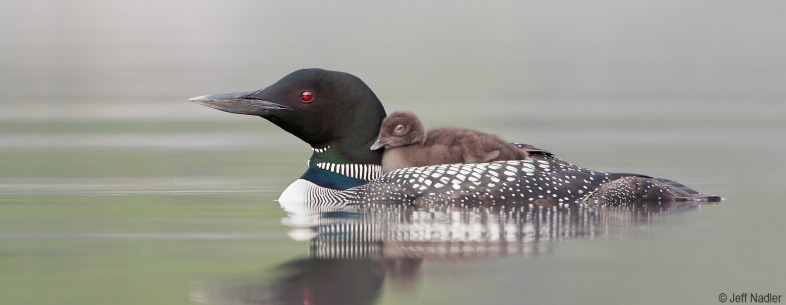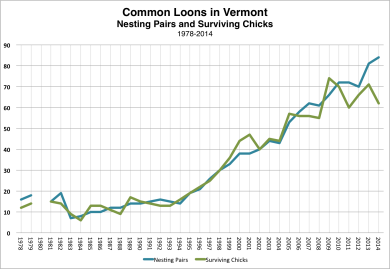One of Vermont’s greatest wildlife conservation triumphs is the return of the Common Loon. From a mere seven pairs three decades ago, Vermont’s loon population has steadily climbed to 84 pairs in 2014. But in recent years, something unusual has been happening among Vermont loons.
As adult loon numbers continue to rise, the number of surviving chicks appears to have leveled off to an average of 67 per year over the past six years. Although it’s too early to conclude that the loon population has reached some sort of demographic plateau, here at VCE we’re watching these chick numbers and working to enhance the conservation of Common Loons in Vermont.
In 1978, with the statewide nesting loon population at alarmingly low levels, the Vermont Fish and Wildlife Department (VFWD) and the Vermont Institute of Natural Science (VINS) implemented a recovery plan for this species.
For the past seven years, VCE has run the program which features:
- Monitoring – We can’t protect loons unless we know where they are and how well they’re doing. Our committed corps of volunteer loon watchers has been indispensable to biologists working on loon protection and recovery.
- Management – We’ve advised lakeside landowners and lake visitors on practical protection measures. Floating signs warn boaters to stay clear of loon nests. We’ve worked with hydroelectric dam operators to stabilize reservoir levels during loon nesting season. And where we can’t stabilize lake levels, our “nesting rafts” mimic islands and help loons succeed when waters rise or fall.
- Outreach – VCE’s outreach strategy, featuring educated volunteers, public presentations, media interviews, fact sheets, and other publications, helps people enjoy loons from a proper distance while fishing, boating, and swimming.
The plan has worked. So successful was the recovery that the Common Loon was removed from the Vermont Endangered Species List in 2005.
Although loons are back, VCE’s loon biologist Eric Hanson points out that our legacy of success depends on continued monitoring, management, and outreach. “We can’t rest on our laurels,” says Hanson. “Roughly half the loon nesting sites in Vermont are at high risk of human disturbance.”
The Plateau of Chicks
A casual look at the numbers reveals that during the last six years, additional loon nests haven’t always led to more surviving chicks overall. Any number of factors can be behind these results. Weather, for example, can play a huge role in loon nesting success and chick survival from year to year.
“For nearly two decades, Vermont’s chick productivity has been off the charts with each pair averaging more than seven chicks in a 10-year period, compared to the national average of five chicks over 10 years,” said Hanson. “Any leveling off in chick production could be the result of normal competition and availability of resources and may indicate that Vermont’s population is reaching carrying capacity.”
Nevertheless, we’re investigating factors that may be limiting nesting success and chick survival. Here are a few hypotheses:
- With increasing numbers of adults joining the statewide population, new loon pairs may now be forced to choose ponds that provide marginal habitat and water quality.
- Bald Eagles, whose numbers are also rising, may be preying upon more Common Loon chicks here in Vermont.
- Competition among adults for territories and nest sites may result in disruption of breeding behavior.
One other possibility is people. Successful management of the Common Loon breeding population is very labor intensive. With higher numbers of nesting loons, perhaps we ourselves have reached some sort of capacity to monitor and effectively protect loon nest sites.
Winter Concerns
No view of loon success is complete without consideration of wintering habitat. Vermont loons winter off the New England coast, where oil spills from ships are a genuine concern. Although two such spills in the past 18 years killed more than 1,000 loons, fortunately they did not have a discernable effect on Vermont loons.
“Nearly every breeding loon in Vermont winters along the southern New England coast,” says Hanson. “One disaster – and all our recovery work here in Vermont could be set back by decades.”
Yet overall, the Common Loon story in Vermont has been overwhelmingly positive, thanks in large part to VCE’s and VFWD’s conservation efforts and a high level of loon awareness by Vermont boaters and lakeshore owners.
“By having the Common Loon as a bellweather, we’re also helping to maintain, if not improve, the ecological health of our lakeshores and waters,” said Hanson. “It’s good for loons and good for other wildlife as well.”


